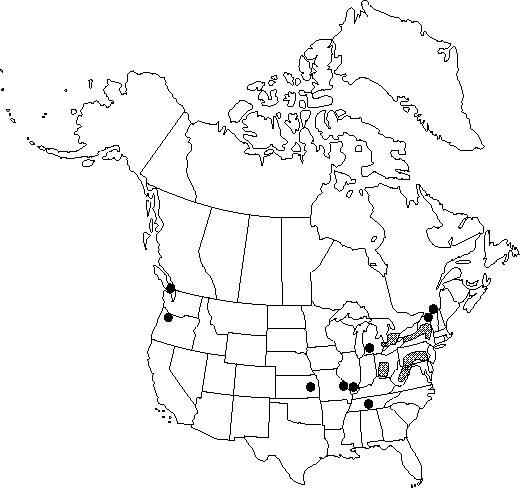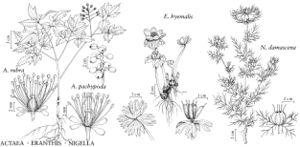Difference between revisions of "Nigella damascena"
Sp. Pl. 1: 534. 1753.
FNA>Volume Importer |
FNA>Volume Importer |
||
| Line 23: | Line 23: | ||
}}<!-- | }}<!-- | ||
| − | --><span class="statement" id="st- | + | --><span class="statement" id="st-undefined" data-properties=""><b>Stems </b>erect, slender, 10-75 cm, glabrous. <b>Leaves</b> 2-16 cm; basal leaves petiolate, segments wider than ±sessile cauline leaves. <b>Inflorescences</b>: involucral bracts whorled, similar to cauline leaves, curving up to surround flower. <b>Flowers</b> 10-50(-60) mm diam.; sepals blue, sometimes pink or white, short-clawed, 8-25 × 3-15 mm, apex entire to irregularly incised or lobed, occasionally lacerate; petals clawed, abaxial lip distally 2-lobed, bearing 2-3 nectar glands or apex expanded, adaxial lip scalelike. <b>Capsules</b> smooth, 8-35 mm; locules 5-10; beak persistent, slender.</span><!-- |
-->{{Treatment/Body | -->{{Treatment/Body | ||
| Line 29: | Line 29: | ||
|habitat=Dump sites and waste places | |habitat=Dump sites and waste places | ||
|elevation=0-400 m | |elevation=0-400 m | ||
| − | |distribution=B.C.;Ont.;Que.;Ill.;Kans.;Md.;Mich.;Mo.;N.Y.;Ohio;Oreg.;Pa.;Tenn.;W.Va.;native to Eurasia | + | |distribution=B.C.;Ont.;Que.;Ill.;Kans.;Md.;Mich.;Mo.;N.Y.;Ohio;Oreg.;Pa.;Tenn.;W.Va.;native to Eurasia. |
|discussion=<p>Nigella damascena is frequently cultivated as an ornamental and for dried-flower arrangements. It occasionally escapes cultivation and may become established. Populations in Ontario and Quebec, and probably elsewhere, are short-lived.</p><!-- | |discussion=<p>Nigella damascena is frequently cultivated as an ornamental and for dried-flower arrangements. It occasionally escapes cultivation and may become established. Populations in Ontario and Quebec, and probably elsewhere, are short-lived.</p><!-- | ||
--><p>Most North American populations of Nigella damascena are represented by a mixture of single- and double-flowered (having supernumerary flower parts) individuals. Sepals tend to be larger and more variable in color than in Eurasian plants. Single-flowered plants usually have petals; petals appear to be absent in double-flowered individuals.</p> | --><p>Most North American populations of Nigella damascena are represented by a mixture of single- and double-flowered (having supernumerary flower parts) individuals. Sepals tend to be larger and more variable in color than in Eurasian plants. Single-flowered plants usually have petals; petals appear to be absent in double-flowered individuals.</p> | ||
| Line 50: | Line 50: | ||
|habitat=Dump sites and waste places | |habitat=Dump sites and waste places | ||
|elevation=0-400 m | |elevation=0-400 m | ||
| − | |distribution=B.C.;Ont.;Que.;Ill.;Kans.;Md.;Mich.;Mo.;N.Y.;Ohio;Oreg.;Pa.;Tenn.;W.Va.;native to Eurasia | + | |distribution=B.C.;Ont.;Que.;Ill.;Kans.;Md.;Mich.;Mo.;N.Y.;Ohio;Oreg.;Pa.;Tenn.;W.Va.;native to Eurasia. |
|introduced=true | |introduced=true | ||
|reference=None | |reference=None | ||
| Line 56: | Line 56: | ||
|publication year=1753 | |publication year=1753 | ||
|special status=Selected by author to be illustrated;Introduced | |special status=Selected by author to be illustrated;Introduced | ||
| − | |source xml=https://jpend@bitbucket.org/aafc-mbb/fna- | + | |source xml=https://jpend@bitbucket.org/aafc-mbb/fna-data-curation.git/src/9216fc802291cd3df363fd52122300479582ede7/coarse_grained_fna_xml/V3/V3_205.xml |
|genus=Nigella | |genus=Nigella | ||
|species=Nigella damascena | |species=Nigella damascena | ||
| − | |||
| − | |||
| − | |||
| − | |||
| − | |||
| − | |||
| − | |||
| − | |||
| − | |||
| − | |||
| − | |||
| − | |||
| − | |||
| − | |||
| − | |||
| − | |||
| − | |||
| − | |||
| − | |||
| − | |||
| − | |||
| − | |||
| − | |||
| − | |||
| − | |||
| − | |||
| − | |||
}}<!-- | }}<!-- | ||
-->[[Category:Treatment]][[Category:Nigella]] | -->[[Category:Treatment]][[Category:Nigella]] | ||
Revision as of 13:35, 27 July 2019
Stems erect, slender, 10-75 cm, glabrous. Leaves 2-16 cm; basal leaves petiolate, segments wider than ±sessile cauline leaves. Inflorescences: involucral bracts whorled, similar to cauline leaves, curving up to surround flower. Flowers 10-50(-60) mm diam.; sepals blue, sometimes pink or white, short-clawed, 8-25 × 3-15 mm, apex entire to irregularly incised or lobed, occasionally lacerate; petals clawed, abaxial lip distally 2-lobed, bearing 2-3 nectar glands or apex expanded, adaxial lip scalelike. Capsules smooth, 8-35 mm; locules 5-10; beak persistent, slender.
Phenology: Flowering late spring–early fall.
Habitat: Dump sites and waste places
Elevation: 0-400 m
Distribution

B.C., Ont., Que., Ill., Kans., Md., Mich., Mo., N.Y., Ohio, Oreg., Pa., Tenn., W.Va., native to Eurasia.
Discussion
Nigella damascena is frequently cultivated as an ornamental and for dried-flower arrangements. It occasionally escapes cultivation and may become established. Populations in Ontario and Quebec, and probably elsewhere, are short-lived.
Most North American populations of Nigella damascena are represented by a mixture of single- and double-flowered (having supernumerary flower parts) individuals. Sepals tend to be larger and more variable in color than in Eurasian plants. Single-flowered plants usually have petals; petals appear to be absent in double-flowered individuals.
Selected References
None.
